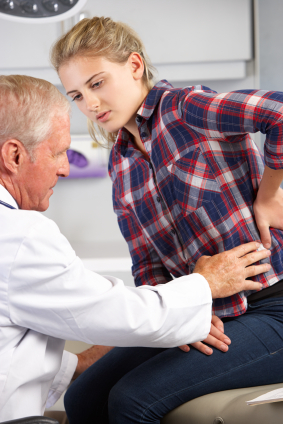When people think of athletes with back pain, they mosty think of pain in the neck or lower back. As a result, the middle part of the spine, called the thoracic spine, is commonly overlooked. But just as other regions of the back, the mid-spine can negatively impact a young athlete's performance and risk of injury.

Why is the mid-back area so important to athletes? Why types of problems can occur? What can be done to reduce risk of injury and improve performance?
Anatomy lesson
In terms of importance, you only have to watch a golfer bring back a driver or a baseball pitcher winding up to throw to see the strain these rotating motions put on the mid-spine and supporting muscles. An injury to the thoracic spine or supporting structures will negatively affect the athlete's ability to generate velocity with rotation.
One reason young athletes are prone to problems with the mid-back is that, in spite of core training programs, most don't maintain good posture over the course of the day. Whether at school or home, sitting in a slouched position causes the muscles to weaken in the mid- and lower trapezoid muscles and to tighten the middle back.
The major concern with a tight middle back is that an athlete, in order to produce the required athletic movement (golf swing, pitch) will likely try to compensate by increasing rotation in the lower back. Unfortunately, the lower back (lumbar region of the spine) has limited ability to rotate, so that the extra strain puts increased pressure on lumbar discs (which can rupture or bulge, putting pressure on the sciatic nerve). Furthermore, the lack of mobility in the upper part of the thoracic spine causes hypermobility in the lower part of the cervical spine, leading to neck and back pain, the cause of which is actually the result of tightness in the mid-back.
Warning signs
An athlete experiencing any of the following symptoms may have a medical condition that should be evaluated by a physician:
- Pain with breathing
- Radiating pain around the ribs with any motion
- Pain at night
- Pain to pressure along the thoracic vertebrae
- Previous spinal stress fractures with reports of pain
Identification
- Have your child place their hands on their hips with elbows out to the side.
- While standing in front of the mirror, see how far they can rotate as far as they can to the left and examine the location of their shoulder. Complete this same motion to the R.
- The shoulder ideally should go past the center of their body (total rotation of about 100 degrees). Lack of rotation is indicative of weakness or tightness. In either case, an appropriate exercise regimen can help ensure proper movement.
Strengthening exercises
- Cat-Back Exercise - On hands and knees, alternately round the middle of the back and then allow it to "sink down" into an extended position. Hold each for 5 seconds. Complete 10-15 times to improve active motion of the thoracic spine.
- Sidelying Rotations with Knees Flexed - Lying on side with knees and hips flexed towards the waist and chest, rotate to the opposite side to stretch the middle back. This differs from the a common exercise people use to "pop" their lower back. With the hips flexed it creates a lumbar lock to force rotation through the center of the spine. Hold each stretch for up to 30 seconds as tolerated. Initially this stretch is difficult to complete but will improve with time. DO NOT PUSH THROUGH PAIN!
- Foam Roller - Place a long foam roller on the ground and lay flat on back, with the roller center in the spine. Make sure the roller is still supporting the head to prevent neck aggravation. Complete 20 repetitions of 5-second holds of squeeze the shoulder blades together. IMPORTANT! If you are very still laying directly on a foam roller may be difficult. Do not push through pain to complete the exercise. Assistance from a personal trainer, physical therapist, or athletic trainer may be necessary if unable to complete due to significant tightness or poor balance.
Posted May 20, 2013








